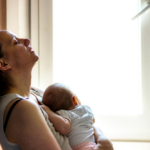Perfect … just not picture perfect
After nine long months of waiting to meet your bundle […]

Cone heads
Most babies have slightly elongated or cone-shaped skulls at birth, since the bones in their skulls are not yet fused. During that tight squeeze out of the birth canal, tiny noggins get temporarily squished and may come out strangely shaped. You can expect your baby’s head to become more round within a few days.
Soft spots
When snuggling up close to your baby and gently stroking her soft hair, you may be alarmed to find she has soft spots on her head. But there’s no need for concern, Marshall assures: “Supple indentations on baby’s head are normal and allow for proper brain growth.” These soft spots, also called fontanels, are openings in the skull, which make it possible for baby to pass through the birth canal. They also accommodate your infant’s growing brain. Soft spots usually take around 18 months to close up.
Funky facial features
With its swollen, puffy eyelids and flattened nose, your baby’s face might give the impression that she was just in a fist fight. But Marshall notes, “When babies are born, their faces often have some swelling and bruising from the regular trauma associated with birth.” Some babies will even burst an ocular blood vessel during labor, leaving red spots in the whites of their eyes. Also don’t be surprised if your little peanut’s lips appear to have blisters. Marshall says this often happens when tots suck their upper lips in utero to self-soothe.
Skin conditions
Many infants are born with as much acne as a teenager. It catches a lot of parents off guard, but it’s totally normal and is just a result of the hormones your baby has been borrowing. Resist the urge to find ways to treat it, as doing so only makes it worse. The best solution: Let it run its course and go away on its own.
When your baby is first delivered, she will be covered in a creamy white substance called vernix. Marshall explains that vernix protects your baby’s delicate skin from drying out and will wash off during her first bath.
Your new addition might also have what appears to be flaky, peeling skin. However, it’s not actually dry skin, Marshall explains, but rather molting older skin that’s making way for a new layer of epidermis. The process is natural and does not require any treatment.
Swollen breasts and genitalia
Newborn babies tend to have swollen breasts and genitals, regardless of gender. According to Marshall, this has to do with maternal hormones. “The swelling of the genitals goes away pretty quickly, but the swelling of the breast tissue can take about six weeks to disappear.”
In addition to swelling, babies’ nipples can release a milky substance, which is absolutely normal. Other unexpected occurrences? Newborn girls can have bloody vaginal discharge right after birth, and infant boys often have erections.
Bowed or bent legs and feet
Infants appear to have bowed legs, but Marshall clarifies that it’s nothing to be concerned about: “Babies hold their legs funny because of the position they were in while in utero, so their muscles are a bit tight.” Their legs usually begin to straighten out as they become mobile.
Stork bites
It isn’t unusual for babies to be born with birthmarks. A common type is the “stork bite,” which is a reddish or brownish patch usually on or near baby’s face. Marshall reassures that they aren’t harmful: “Stork bites are simply blood vessels that are close to the skin, and there’s nothing that needs to be done about them.” While some of these marks may occasionally remain for life, most of them go away during baby’s first year.
Realizing what newborns really look like can help you have a realistic vision of the moment you meet the newest member of your family. Rest assured, when you see your little one, you will know, regardless of how strange she might look upon first glance, that she is the most beautiful, perfect baby in the whole world.







